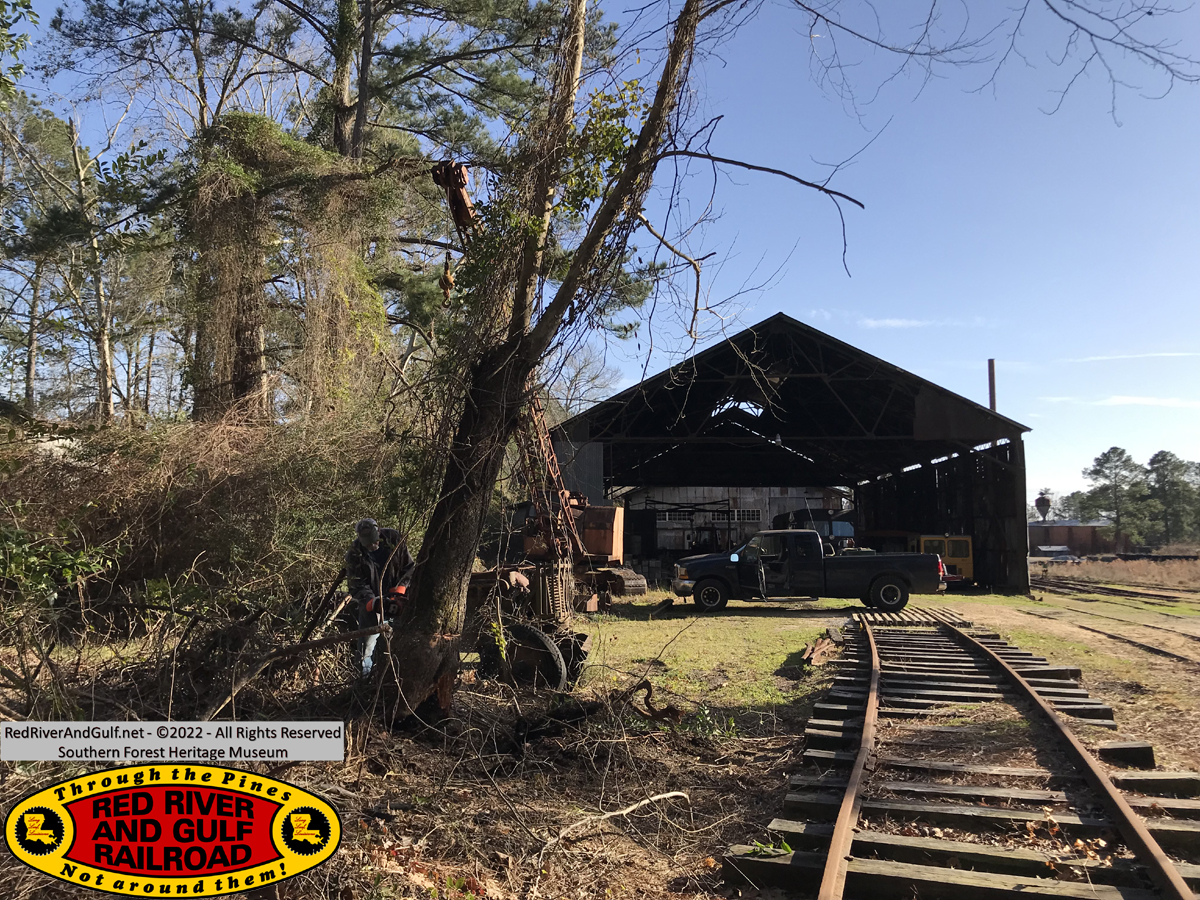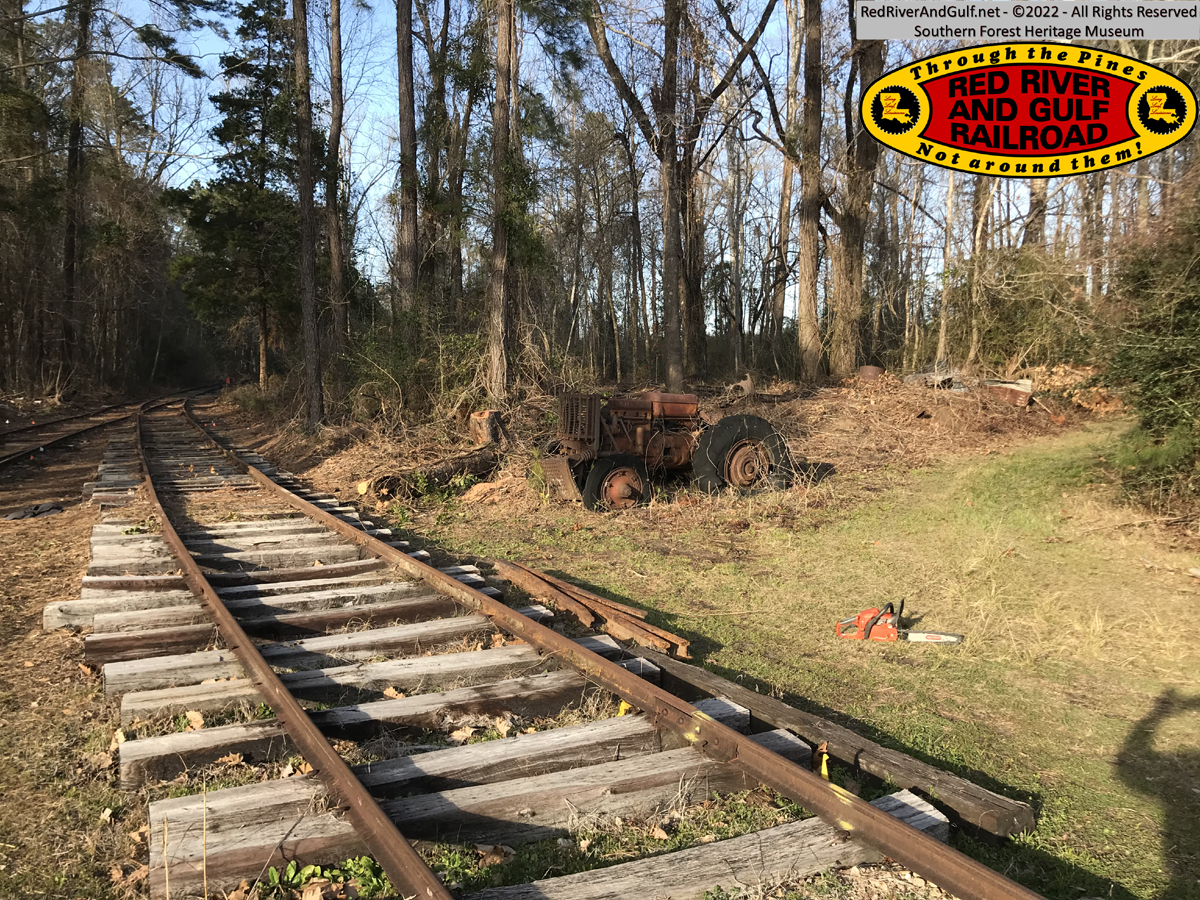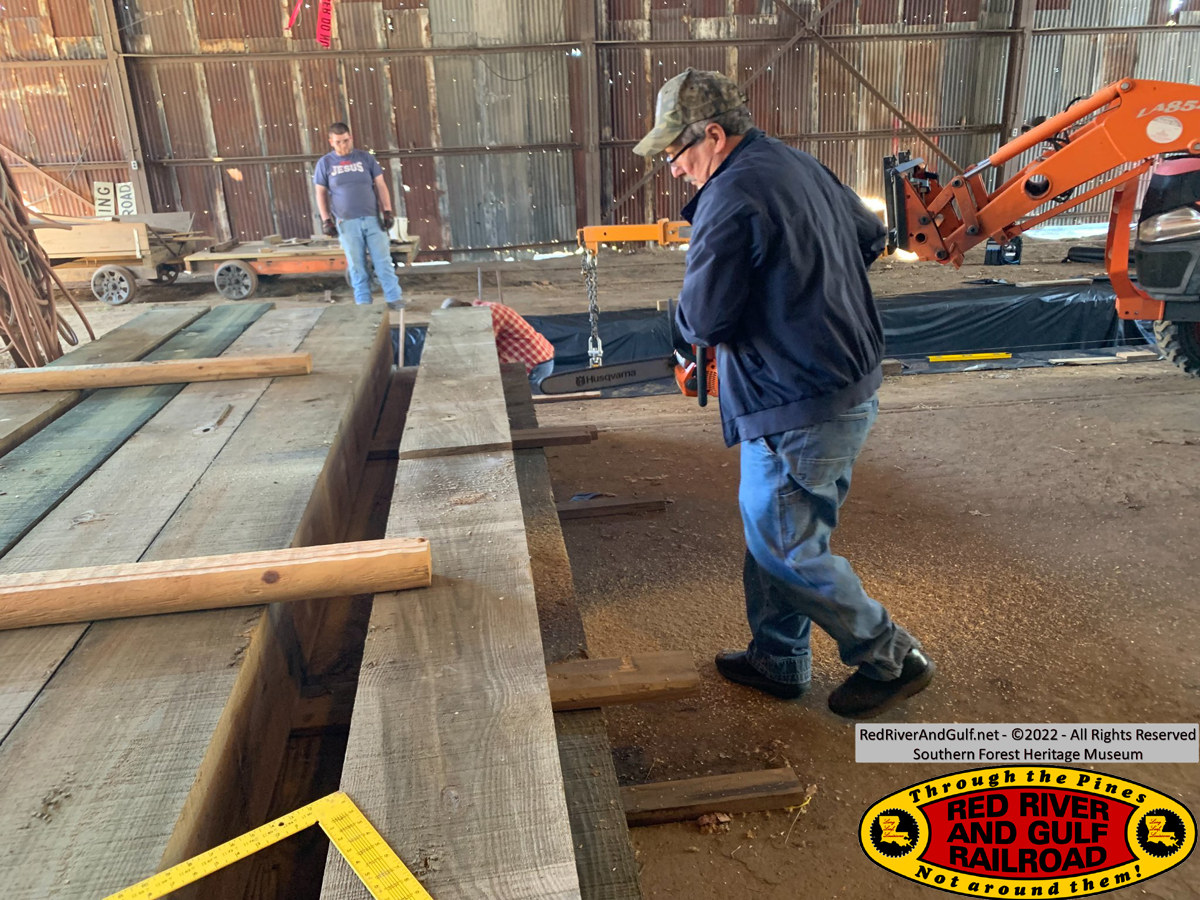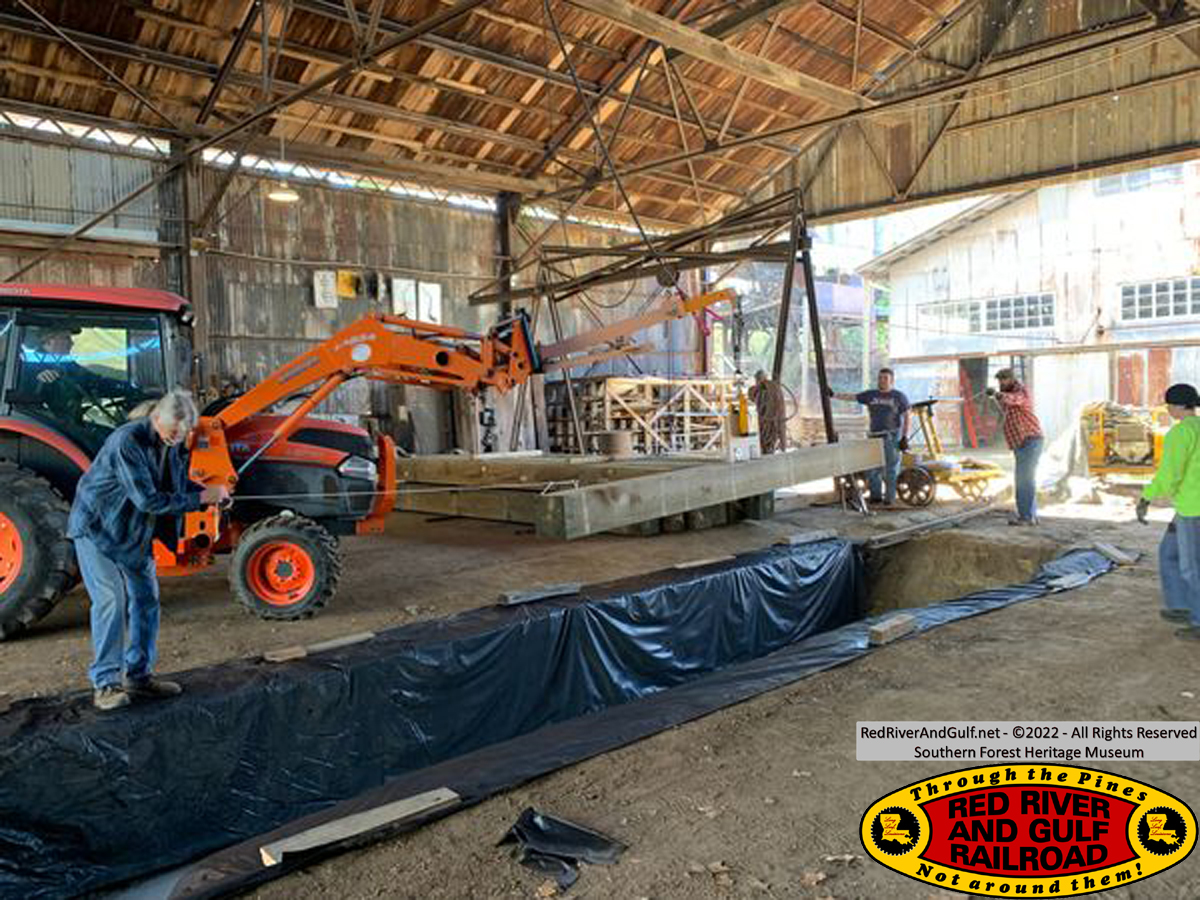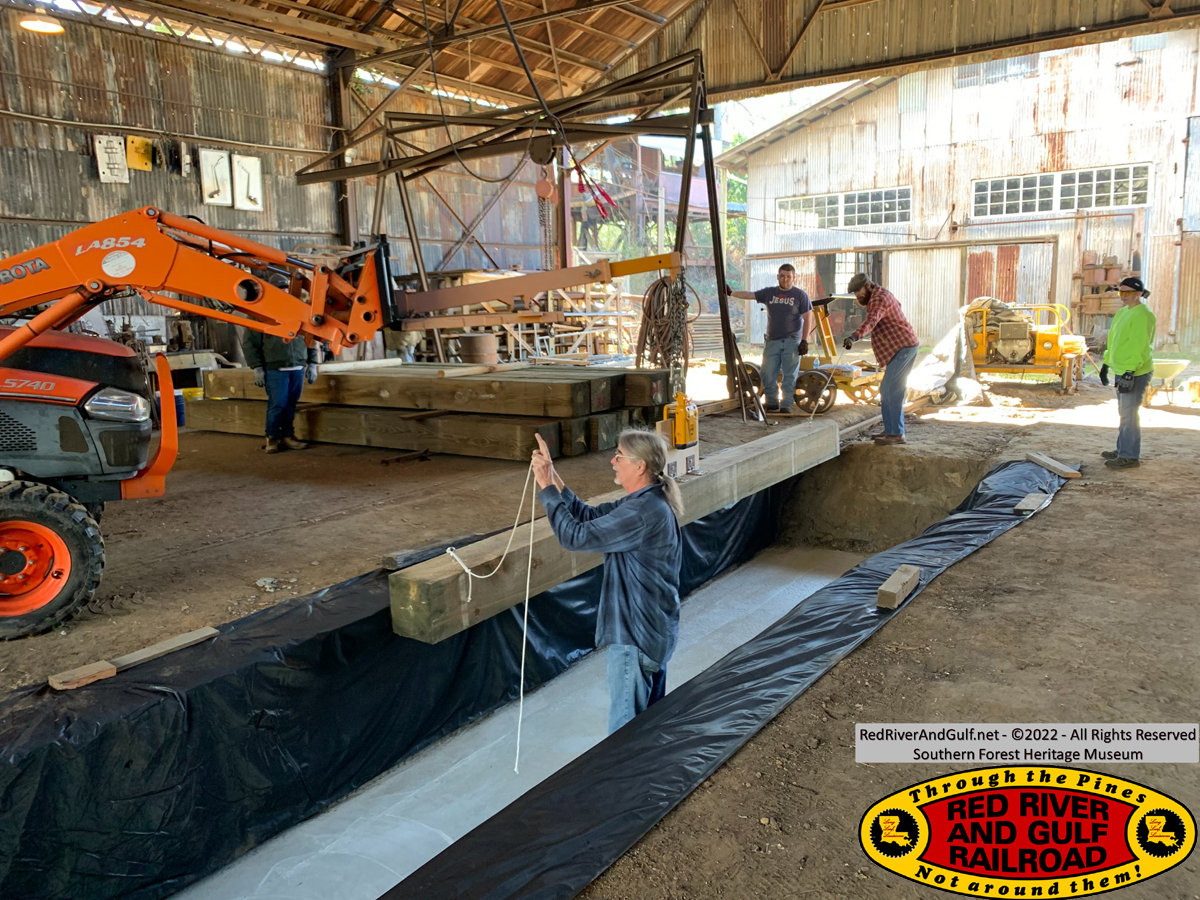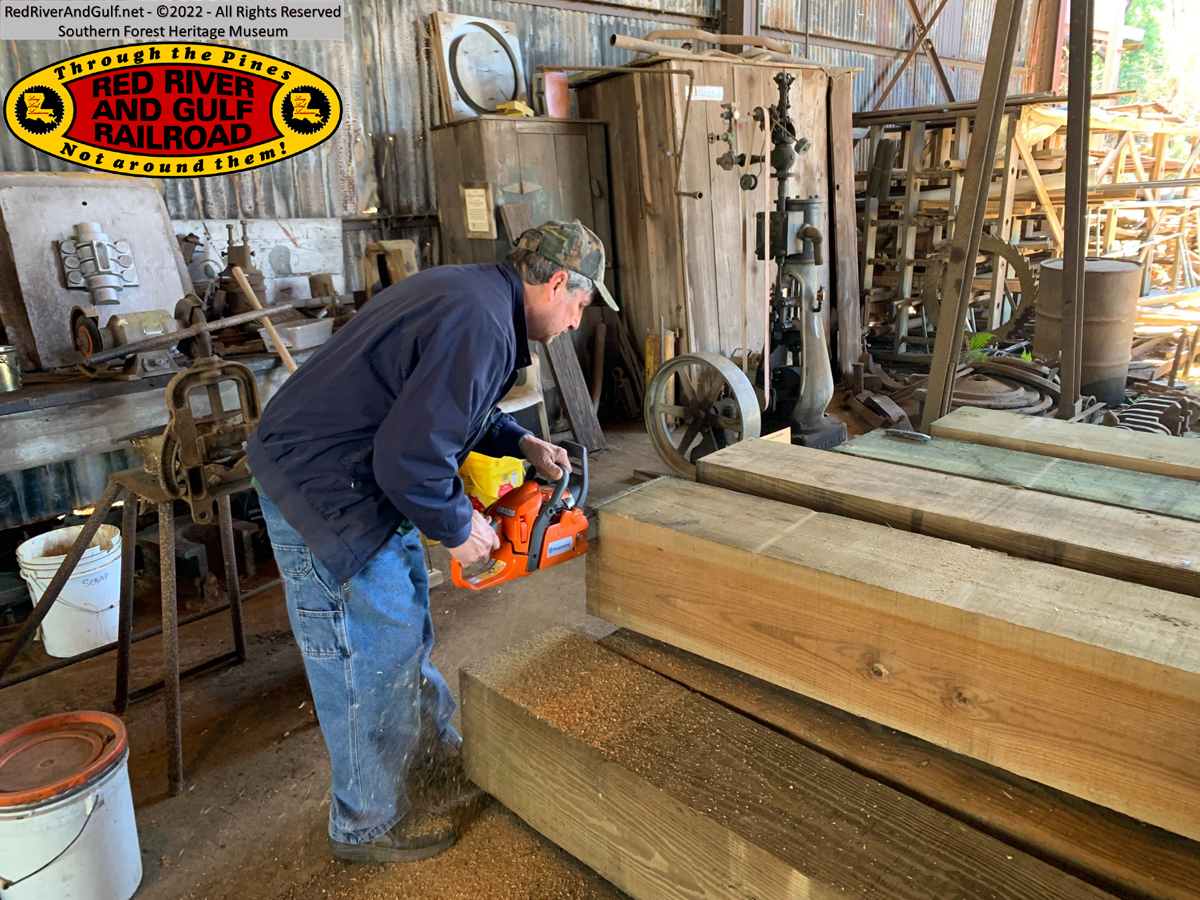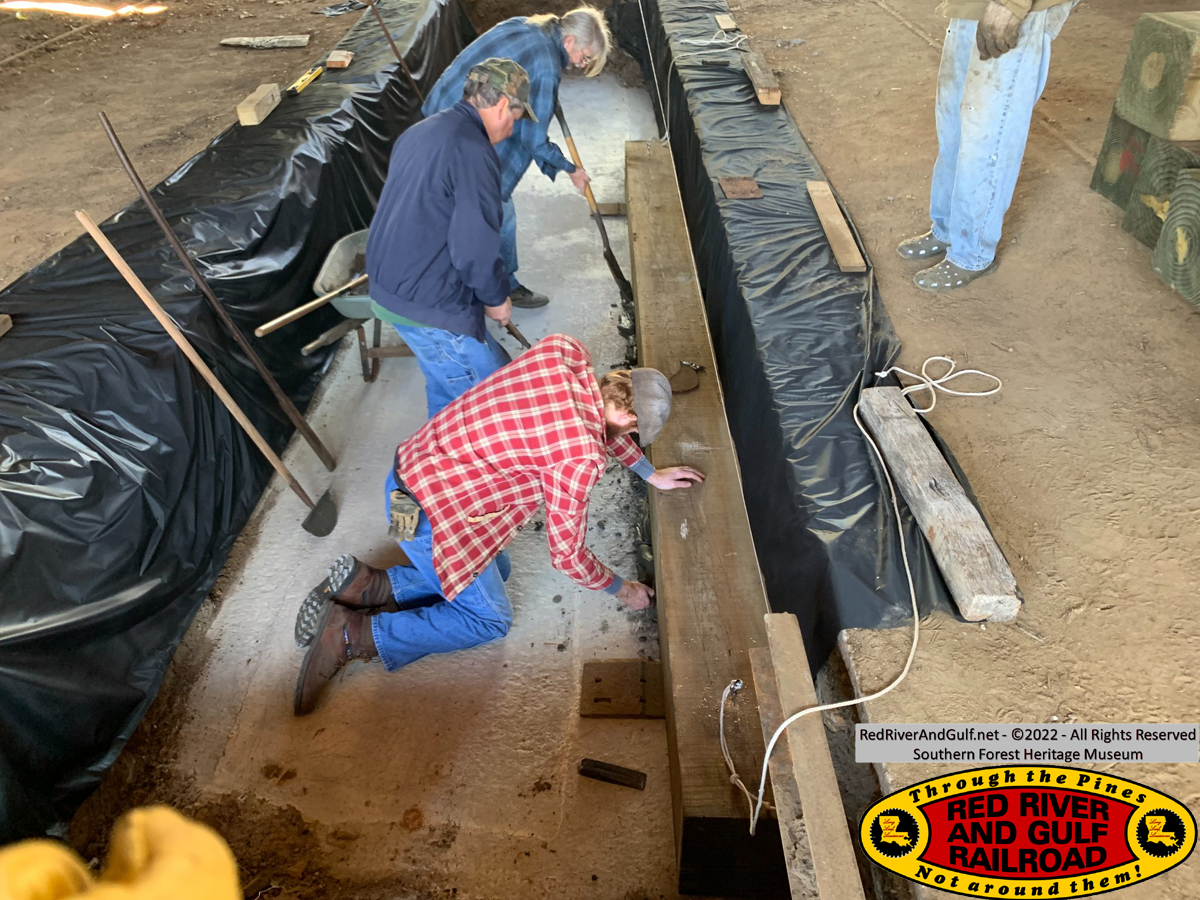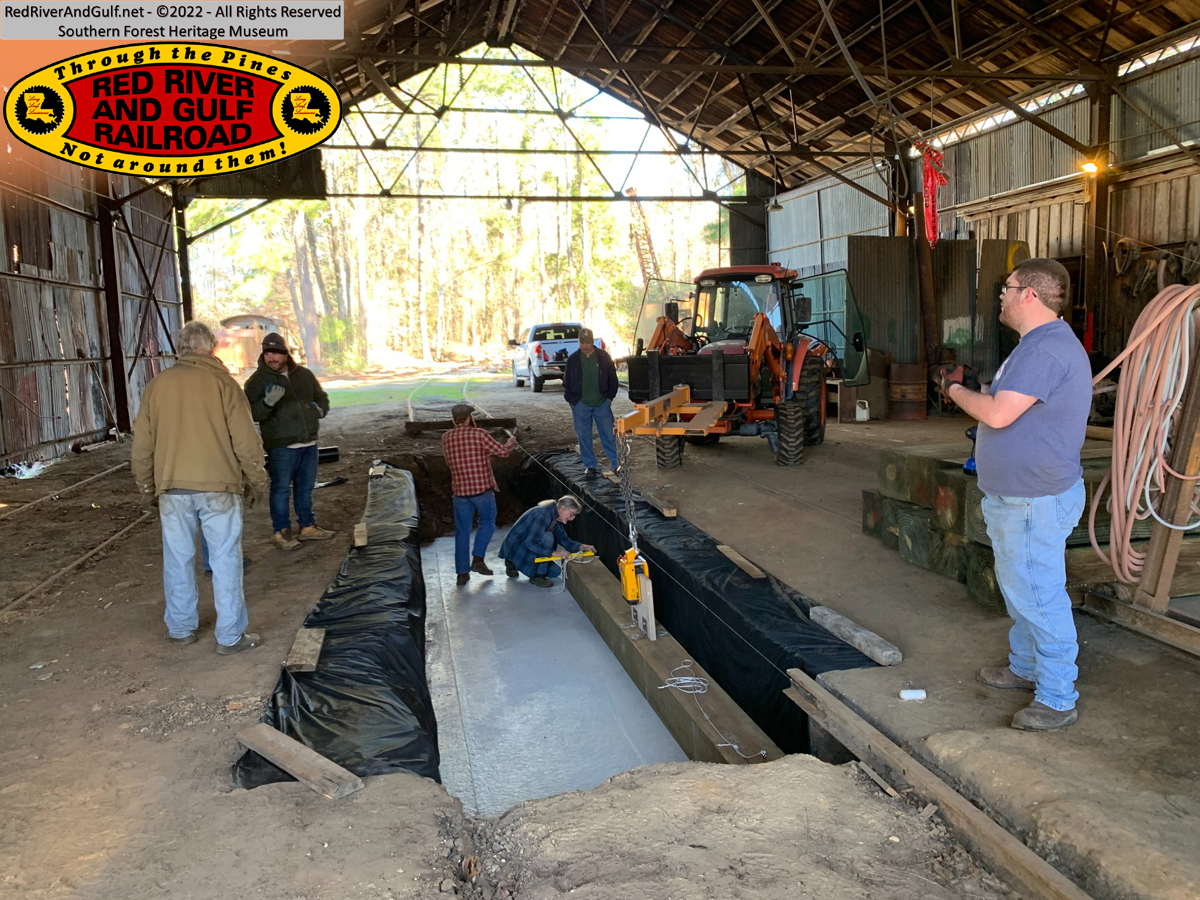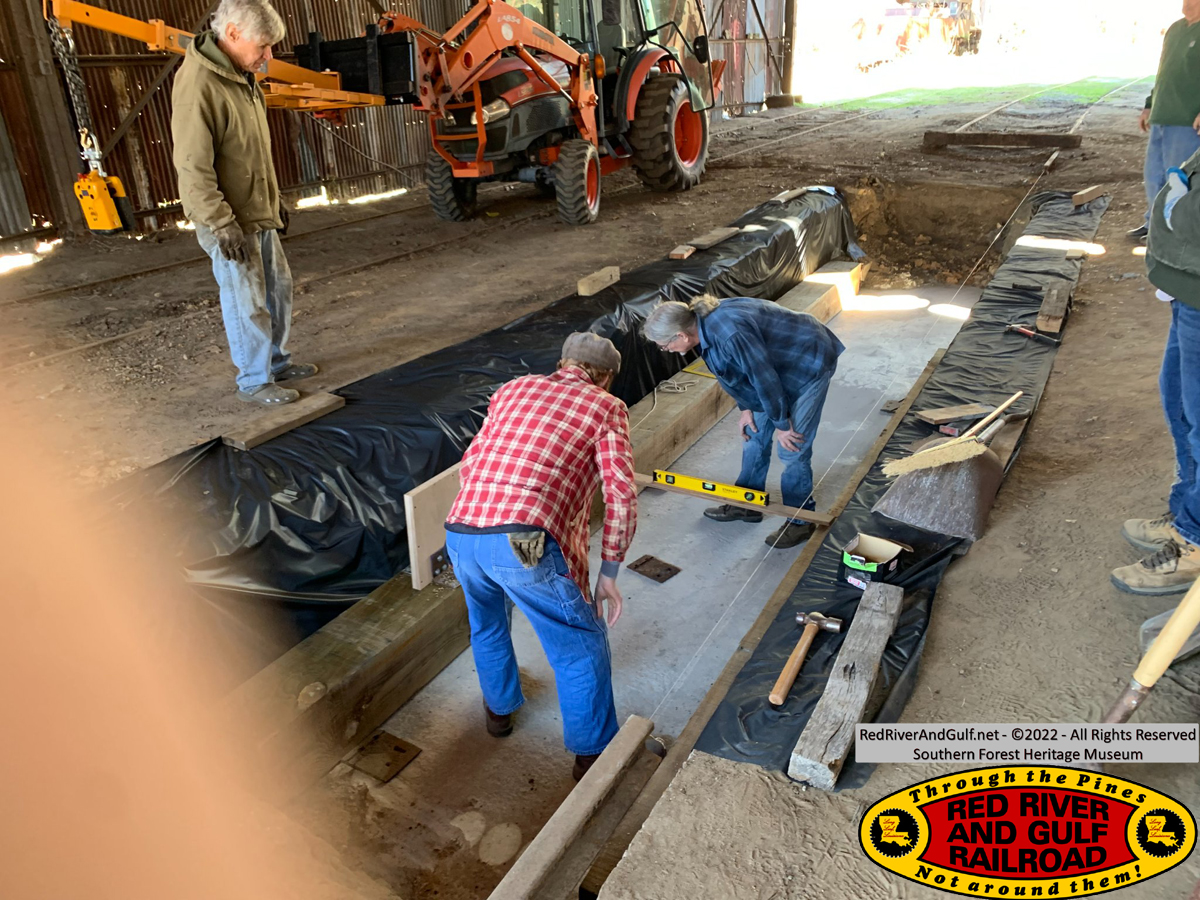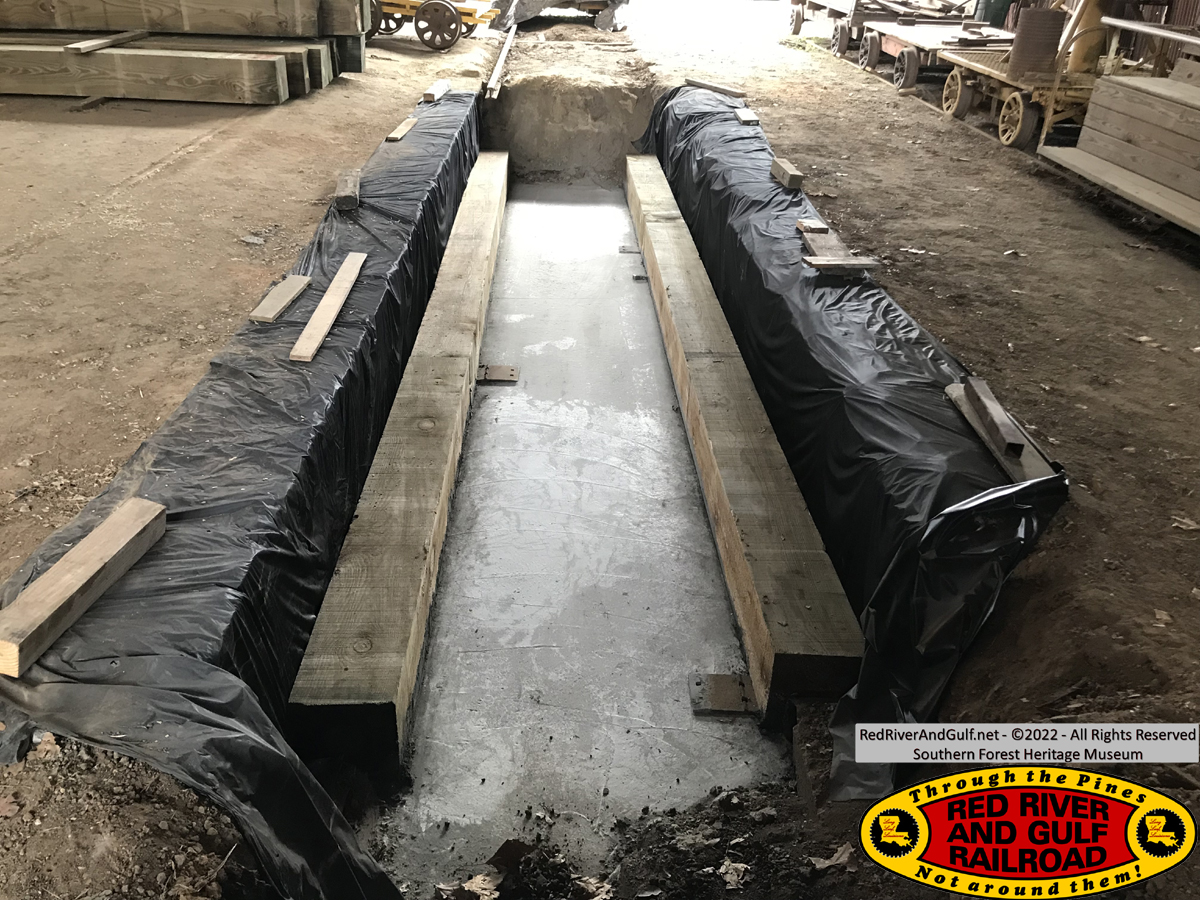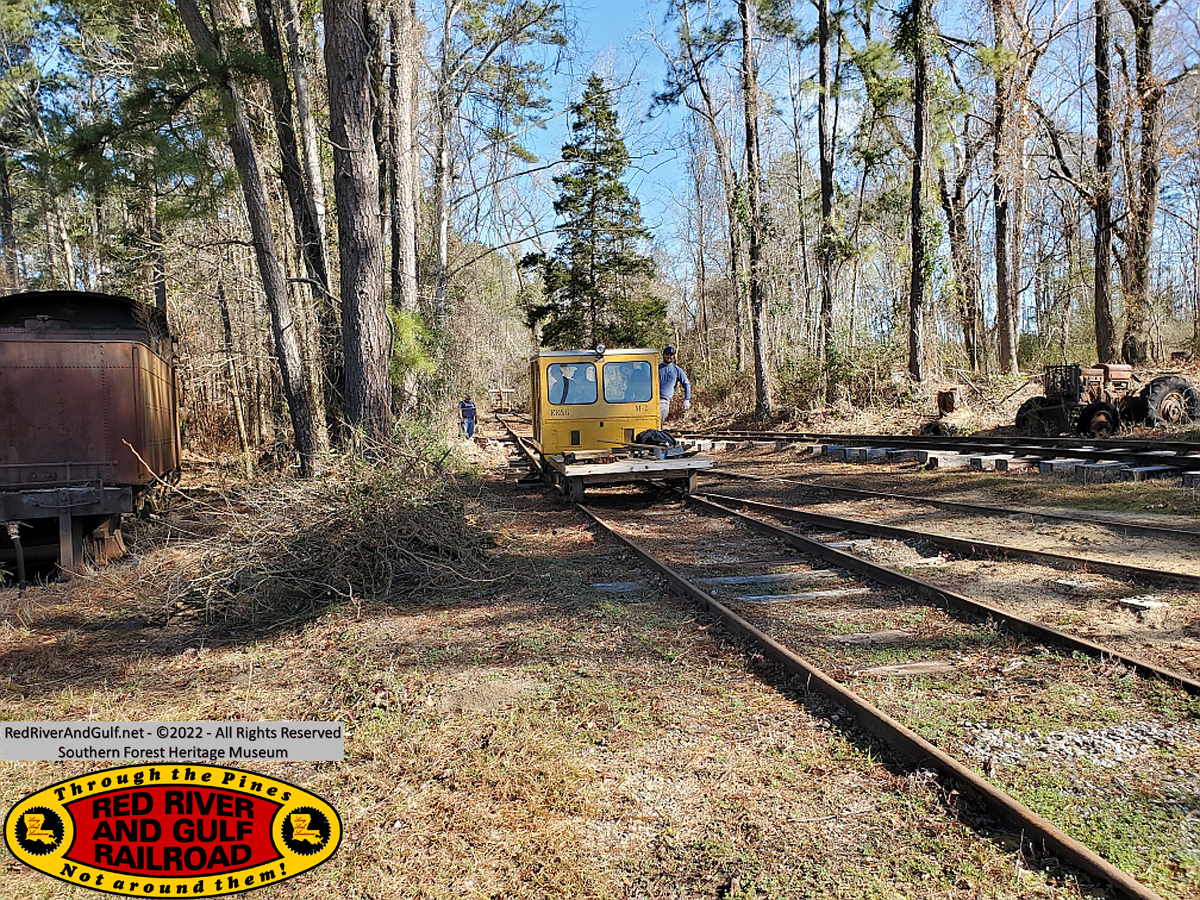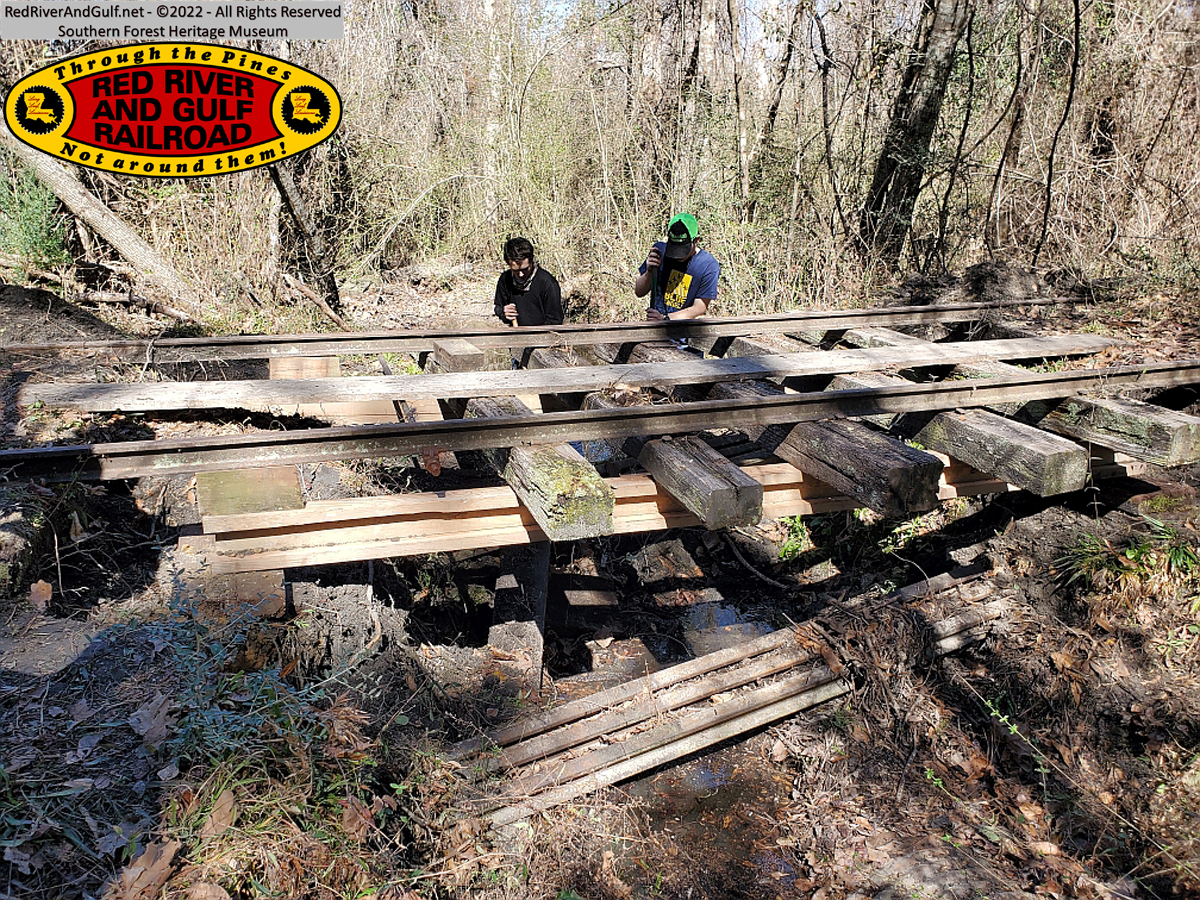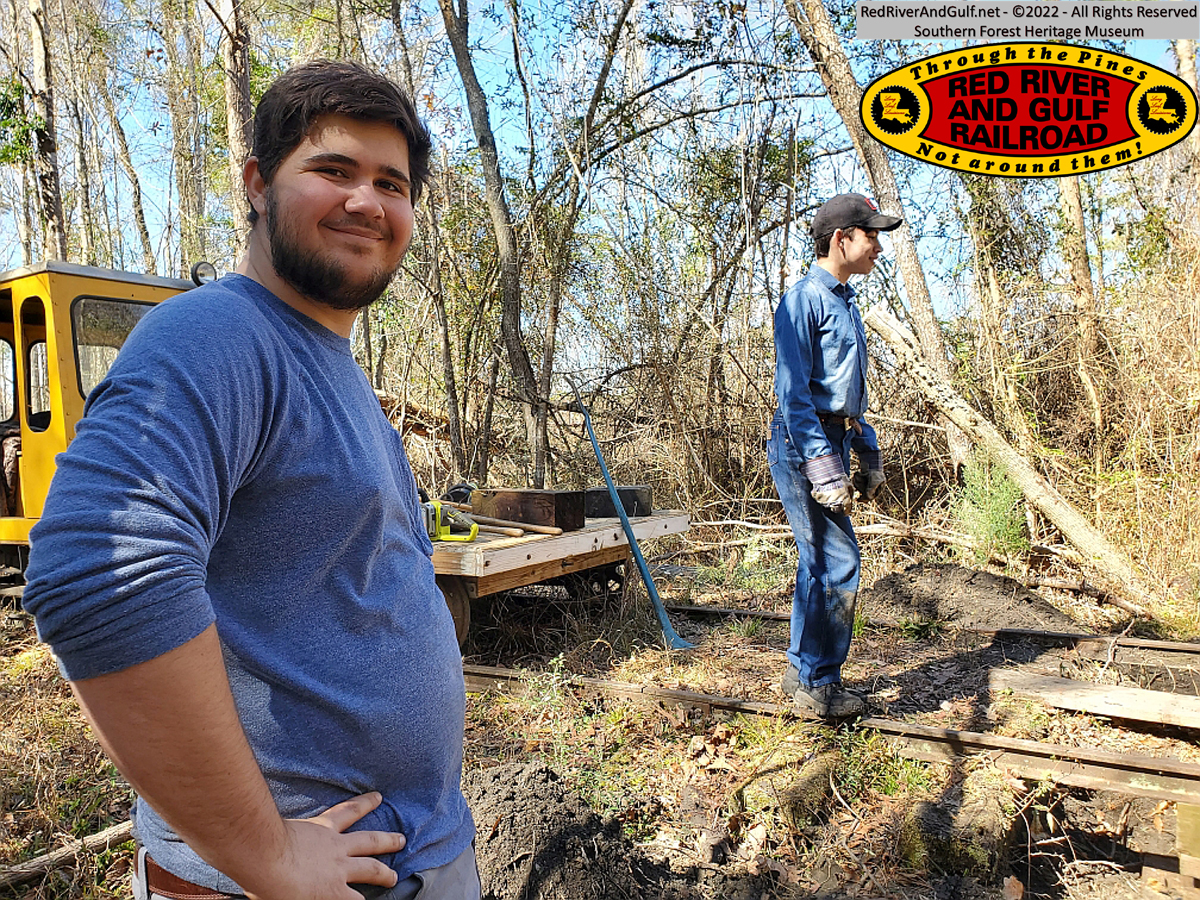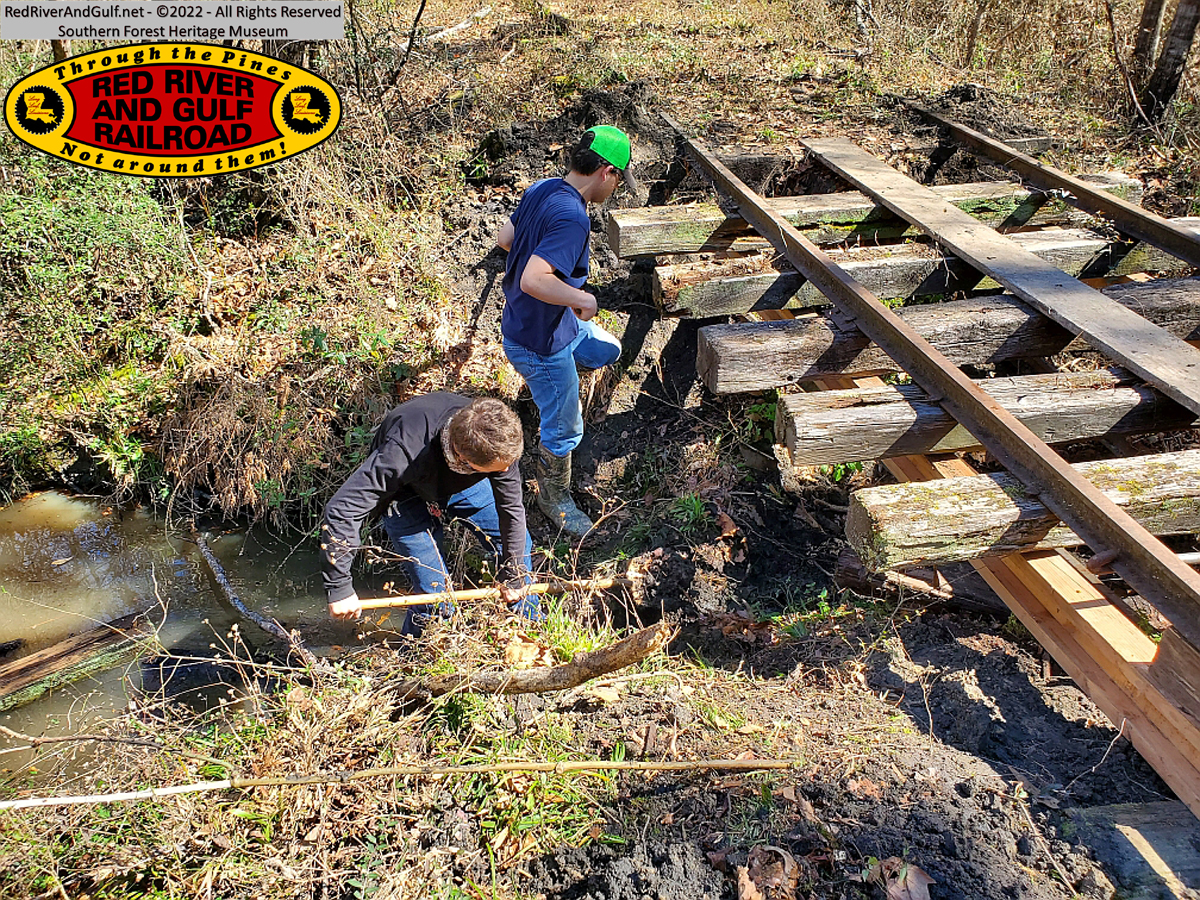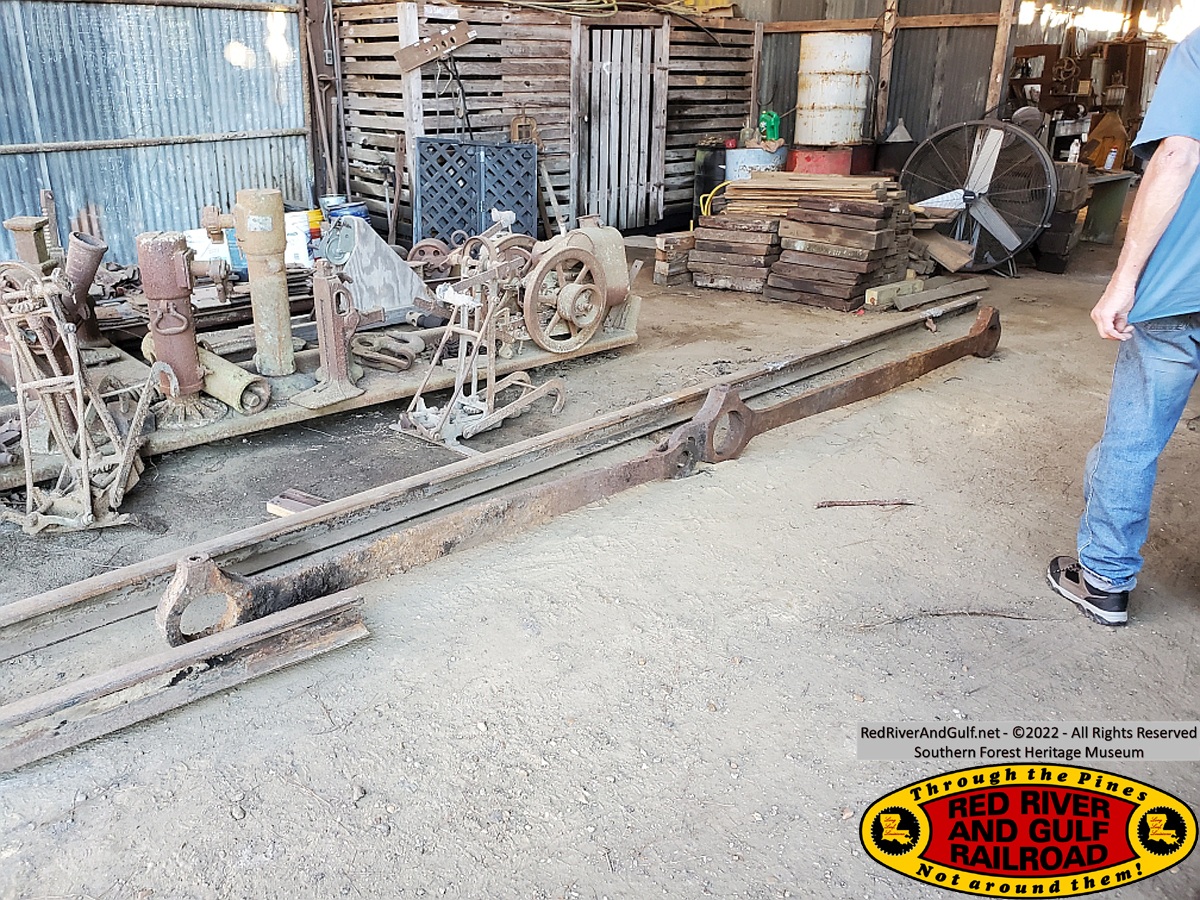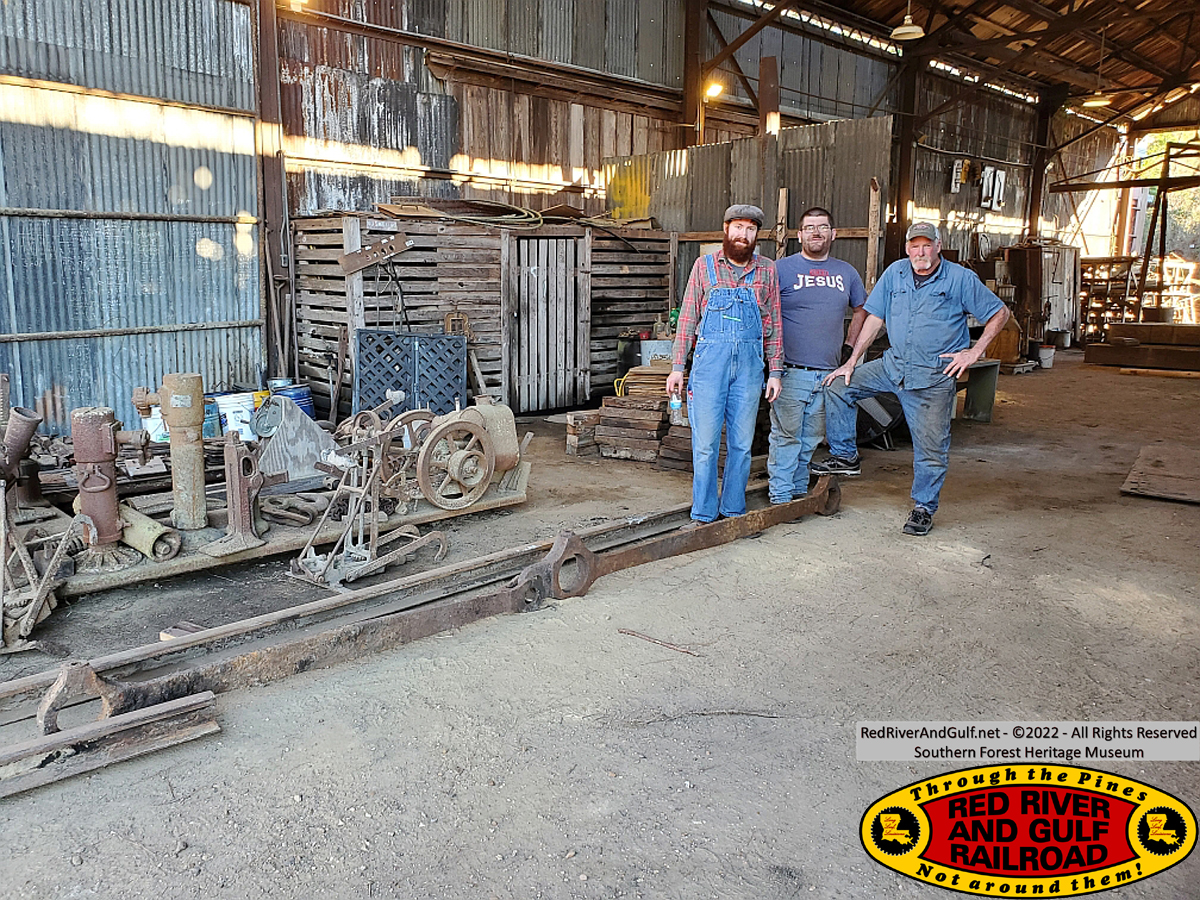|
Volunteer
Railroaders:
1. Chuck L.
2. Don. F
3. Mike M.
4. Mike B.
5. Everett L.
6. Jacques D.
7. Glen A.
8. Wimbley V.
9. Clint L.
10. David H.
11. Dwayne S.
12. Angela A.
13. Andrew A.
14. Kevin P.
15. Doug R.
16. Robin
17. Blake
Accomplishments
1. Naval Stores building interior
walls installation continues
2. Renovation of the kitchen in the superintendent’s house (museum
office)
3. Nuisance sycamore tree near Engine House lead track #2 removed
4. First layer of pit timbers installed and grouted in Engine House
5. Railroad bridge over Grigsby Gulch stabilized for motorcar service
6. Locomotive side rods from C&S #100 located and recovered for research
and display
7. Safety chain for museum trailer welded together
Wednesday 2/16/22 and
Thursday 2/17/22
Chuck and Don worked Wednesday and Thursday at the Naval Stores building
working on the interior walls. Part of this work includes working on the
carpentry of the corner where a tree trunk will be displayed showcasing
a sap bucket. The interior construction of the naval stores building is
close to completion and work on the exhibit space will begin soon.
Friday 2/18/22
The morning was filled with productive meetings for board members. In
the afternoon, Everett headed into Alexandria to scan historic
photographs at the Louisiana History Museum involving local railroads
and forestry. Tucker assisted Larry in moving scaffolding from the car
knocker’s shed down to the museum office, the former mill
superintendent’s house. Museum staff Robin and her husband, Blake, have
donated new flooring for the office kitchen and have undertaken repairs
and renovation to the kitchen, all on volunteer time. A leak in the roof
near an old chimney has been fixed and the new floors they installed are
an excellent upgrade. The scaffolding was needed to reach the ceiling
and the upper walls for repainting. Look inside the museum office the
next time you visit! Robin and Blake have donated both time and
materials for these improvements and we salute the museum staff on these
efforts.
At the Engine House, Glen was testing a method to lift and maneuver the
new timbers into the pit. Each 12”x12”x16’ timber weighed in at just
about 1000 pounds and placing them into the pit in the exact right spot
was quite a challenge. Glen brought his marble/granite clamp, which
could rotate, and pivot as needed, and using some high-quality plywood
and brackets, affixed a wooden “handle” on the timber. The handle was
the 1’x1’ square of plywood with bolts and brackets affixed to the
timber. This allowed the clamp, installed on the front forks of Glen’s
tractor, to grab the handle, lower the timber into the pit, remove the
clamp, and then remove the handle, leaving the timber in just the right
spot. Testing this method on Friday ensured an efficient Saturday
working with the timbers.
Later that afternoon, David Hearne came by, and with his chainsaw, a
nuisance old sycamore tree near Engine House track #2 was felled, cut
up, and moved aside. This is part of our ongoing efforts to remove
trees, brush, and vegetation near historic buildings and the historic
railroad right of way. While cleaning up and sizing up the nearby area
for further clearing efforts, David spotted what we believed to be the
end of a locomotive tender drawbar near locomotive #400. The next day
this artifact would be investigated further.
Wrapping up the afternoon, I rounded up the equipment and materials for
Saturday. A wheelbarrow, a garden hoe, an edger, a leaf shovel, and a
broom were brought up to the Engine House and staged for Saturday. Mike
Miller had already purchased the needed grout and staged the bags in the
Engine House. The museum chainsaw was checked and topped off with fuel.
Saturday 2/19/22
A full crew turned out for Saturday, and much was accomplished in many
teams. Firstly, David Hearne donated his skills to attach a safety chain
for the museum trailer, which Doug had worked tirelessly on getting
plated. Having a trailer with a license plate will be a big help in
securing donated materials for the museum, including crossties. The
trailer had eyes to attach the chains and David donated midlinks and
hooks to attach the chain without any welding. David also installed a
wiring kit to have the lights functional on the trailer. Doug reported
on Monday that the paperwork is now all to receive the license plate for
the trailer.
Crew #2 of Everett, Jacques, Angela, Dwayne, Wimbley, and Clint began
work early in the morning. The first items were moving the M4 down to
the commissary and moving out the equipment from Engine House track #1.
This track was cleared so crew #3 could begin installing the new timbers
for the pit with Glen’s tractor.
After the switching movements, crew #2 headed out with a flatcar loaded
with tools and timbers to make stabilization repairs on the bridge over
Grigsby Gulch. This bridge is located on the former Planer Mill bypass
track, which historically headed into the commissary and passenger depot
area. Today, this track forms one of the three legs of the “wye” and is
often referred to as the “switchback tracks.” In the early days of the
museum, these tracks were used to provide motorcar rides from the
commissary up to the Engine House, “switch backing” up the grade. The
footings for the bridge, originally built by Grigsby and the Reader
Railroad crew, had fallen in due to major erosion and drainage issues.
Everett had fabricated two new timber “I-beams” and these beams were
installed to provide stability for the bridge stringers. Dirt was
cleared away to access the bridge stringers and a gauge bar installed to
keep the rails in gauge. These repairs are to provide for temporary
crossing this drainage to facilitate repairs and maintenance to the
bridge and to the track on the other side.
Crew #3 of Glen, MB, Mike, Tucker, Andrew, and Kevin were at the Engine
House installing the first layer of timbers in the pit. The broom and
leaf shovel were used to give the concrete floor in the pit a thorough
cleaning. Our goal was to place the timbers as evenly and exactly as
possible to ensure as little “rocking” of the timbers as possible.
Eyelets were drilled into the timbers and rope was used to guide the
ends of the timbers down into the pit. Glen’s handle and clamp system
worked very well, and the rope guides allowed us to efficiently maneuver
the timbers into place. After the timbers were place, grout was mixed up
in several batches and the timber bottoms were grouted to ensure a
smooth, even contact with the concrete floor and to ensure no “timber
rocking.” Black vinyl was draped over the walls to provide a vapor
barrier between the treated timbers and the dirt. Mike Brown donated the
roll of black vinyl, which washed up at his house during Hurricane Ida,
and we thank him kindly for his donation. Getting the first timber right
was critical, as all the other timbers would key off this one. Multiple
measurements of where the rail would be, distance between timbers, and
timber level were taken throughout the installation process.
Right before lunch, Angela took time to show several groups on a great
tour around locomotive #400, the Engine House, the Machine Shop, and
locomotive #106.
After lunch, crew #2, joined by David Hearne, Andrew, Jacques, Everett,
Dwayne, and others, used the museum tractor and chains to investigate
the drawbar we thought we came across Friday. Below is the account from
Everett: “While cleaning behind engine #400 on Friday, David Hearne and
Tucker Baker uncovered the end of what appeared to be an engine drawbar,
so after lunch on Saturday, it was decided to recover this artifact.
After some work by David and Andrew, it was suddenly discovered that
this artifact was a SIDE ROD! Not only that, but there was also a side
rod next to it as well. After recovering both rods, they were identified
as belonging to Crowell & Spencer Lima 2-6-0 #100, (Formerly Alexandria
Lumber Co. second #2 and initially Wausau Southern RR #1, Lima #1193,
built April 1912). This locomotive was used only at the Crowell
operation at Hutton, LA after being acquired from Alexandria Lumber, and
supposedly scrapped at Alco, LA about 1944-45. The discovery of this
pair of rods indicates that the locomotive actually ended up at Long
Leaf along with the other engine from Hutton, C&S #200 (which is well
documented photographically), as no one would have scrapped a
locomotive, unlike any other Crowell locomotive and taken a pair of rods
from Alco to Long Leaf. This opens up another new leaf (bad pun) in our
continuing understanding of Long Leaf History. Many thanks to Tucker,
David and Andrew!”
While the side rod recovering as ongoing, crew #3 continued work
finishing the grouting on the timbers in the pit. Doug, Glen, and Mike,
with assistance from Glen’s straps and tractor, lifted and moving the
small steam engine used for demonstrations and tours in the Engine House
into the Machine Shop. David Hamilton showed Doug the operation and
maintenance of the Engine House earlier in the month. Moving the engine
to the Machine Shop grouped this machine with other demonstration
machines in the shop and freed up much-needed space in the Engine House.
As this operation wrapped up, crew #3 was using the museum tractor haul
off the cut-up sycamore tree to the burn pile. Additionally, a
trailer-load of wood was unloaded to storage, set aside for the first
fire-up of the Heisler.
In the mid-afternoon, as the pit timber operation wrapped up, Jacques,
Angela, and Tucker began moving the M8 and trailers back into Engine
House track #1. Everett, David, Andrew, Dwayne, Clint, and Wimbley
headed out to finish up at the Grigsby Gulch bridge. Earlier in the day,
the M4 made multiple trips around the loop and the M2 with Crew #2 made
a successful trop as well. However, M2 derailed on the curve right after
the road crossing near the Engine House. Thankfully, no one was hurt. At
this point, everyone pitched in the re-right M2 and to make needed track
repairs. Using Glen’s tractor and the museum tractor, M2 was re-righted
back on the track. Upon inspection, the gauge was wide at a joint on the
curve. A quick assembly line of repairs was lined upon. As spikes were
pulled and gauge checks performed, Glen used his tractor bring in fresh
ties from the sawmill pad and used the tractor backhoe attachment to
remove the old ties. David then used the museum tractor to haul the bad
ties off to the burn pile. Seven new ties were inserted, and this
wrapped up the afternoon.
Sunday 2/20/22
On Sunday morning, volunteers were moving early. Mike Brown was working
on the big Hyster forklift. The crew of Everett, Kevin, Jacques, Andrew,
Angela, and Dwayne started work early moving out the M2, gathering the
tools, and getting ready for spiking at the new ties inserted on the
main loop. Before heading out, the brakes were adjusted on M2 to keep
them in proper working order. Within short order, the new ties were
spiked down, and this section of track was brought back to good order.
Moving to the now-stabilized bridge, the crew spiked down and secured
the ties and bridge stringers. After this, we took some time to clear
vegetation, limbs, and debris off the wye tracks and to inspect the
tender frame, wheel sets, and other historic equipment in the area.
While moving the M2 and flatcar back to the Engine House around the main
loop, the M2 derailed behind the old dry kiln. A combination of ballast
stacked against the inside rail and the gauge being tight caused the
left front wheel to climb out of gauge. Using the museum tractor,
blocks, and a lining bar, the M2 was re-righted back on the rail. The
ballast in the area was cleared out, and several sets of spikes were
reset on multiple ties in the area. The goal was to bring the whole area
into proper gauge. After these repairs, the crew returned the equipment
and tools to the Engine House and the weekend concluded.
Discussion, investigation, and reports will be completed regarding the
derailments and repairs to correct the track issues. The weekend went
mostly according to plan, and we thank everyone for their efforts and
their good attitudes the whole weekend. Many major projects are closing
to finishing this spring.
-Tucker "Who Dat" Baker
RR&G Road Master
|
